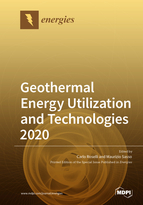Geothermal Energy Utilization and Technologies 2020
A special issue of Energies (ISSN 1996-1073). This special issue belongs to the section "H: Geo-Energy".
Deadline for manuscript submissions: closed (10 December 2020) | Viewed by 43942
Special Issue Editors
Interests: microcogeneration; micropolygeneration; ground source heat pump; desiccant cooling; geothermal energy; energy efficiency; renewable energy; solar heating and cooling; dynamic simulations of energy systems
Special Issues, Collections and Topics in MDPI journals
Interests: energy efficiency; geothermal energy; exergy analysis; microcogeneration; energy communities; gas-engine dirven heat pump; thermoeconomic optimization; dessicant-based HVAC system
Special Issues, Collections and Topics in MDPI journals
Special Issue Information
Dear Colleagues,
The Guest Editors are inviting submissions to a Special Issue of Energies on the subject area of "Geothermal Energy Utilization and Technologies".
The increasing interest in renewable energy sources is also leading geothermal energy toward playing an important role in meeting final energy demand in different countries. It can help to reduce energy dependency on energy imports and vary the energy mix. The applications that could be considered vary from small (residential) to large scale (city). Geothermal energy, unlike other renewable sources, has the significant benefit of being a programmable source, and in this way, it is not dependent on the time of the day or on the weather.
Geothermal energy could be considered for direct use: space heating and cooling, greenhouse heating, aquaculture, bathing, district heating networks, and industrial uses.
Where specific conditions are available (high-temperature hydrothermal resources, aquifer systems medium temperatures, and hot dry rock), geothermal energy could be converted into electricity by means of different technologies (flash steam, dry steam, binary). Cogeneration and polygeneration systems could be also considered to exploit geothermal sources.
In 2017, global geothermal power generation was 84.8 TWh, while the cumulative capacity reached 14 GW. Global geothermal power capacity is expected to reach 17 GW by 2023 as estimated by the International Energy Agency.
The smart energy community also being supported by geothermal sources could be a sustainable and interesting option.
Despite its significant potential, the contribution of geothermal energy to global heating, cooling, and power demand is relatively low. There is therefore a need to focus the attention on the technologies to guarantee a faster spreading and on the policies supporting the exploitation of this source.
This Special Issue will deal with geothermal energy utilization and technologies used for its exploitation considering both direct and indirect use applications. Topics of interest for publication include but are not limited to:
- Geothermal direct use applications (space heating and cooling, greenhouse heating, etc.);
- Cogeneration and polygeneration;
- Geothermal heat pump (ground source heat pump);
- Environmental impacts;
- Social acceptability;
- Smart energy community.
Prof. Dr. Carlo Roselli
Prof. Dr. Maurizio Sasso
Guest Editors
Manuscript Submission Information
Manuscripts should be submitted online at www.mdpi.com by registering and logging in to this website. Once you are registered, click here to go to the submission form. Manuscripts can be submitted until the deadline. All submissions that pass pre-check are peer-reviewed. Accepted papers will be published continuously in the journal (as soon as accepted) and will be listed together on the special issue website. Research articles, review articles as well as short communications are invited. For planned papers, a title and short abstract (about 100 words) can be sent to the Editorial Office for announcement on this website.
Submitted manuscripts should not have been published previously, nor be under consideration for publication elsewhere (except conference proceedings papers). All manuscripts are thoroughly refereed through a single-blind peer-review process. A guide for authors and other relevant information for submission of manuscripts is available on the Instructions for Authors page. Energies is an international peer-reviewed open access semimonthly journal published by MDPI.
Please visit the Instructions for Authors page before submitting a manuscript. The Article Processing Charge (APC) for publication in this open access journal is 2600 CHF (Swiss Francs). Submitted papers should be well formatted and use good English. Authors may use MDPI's English editing service prior to publication or during author revisions.
Keywords
- renewable energy
- geothermal direct use applications
- space heating and cooling
- greenhouse heating
- cogeneration
- polygeneration
- geothermal heat pump
- environmental impacts
- social acceptability
- smart energy community







